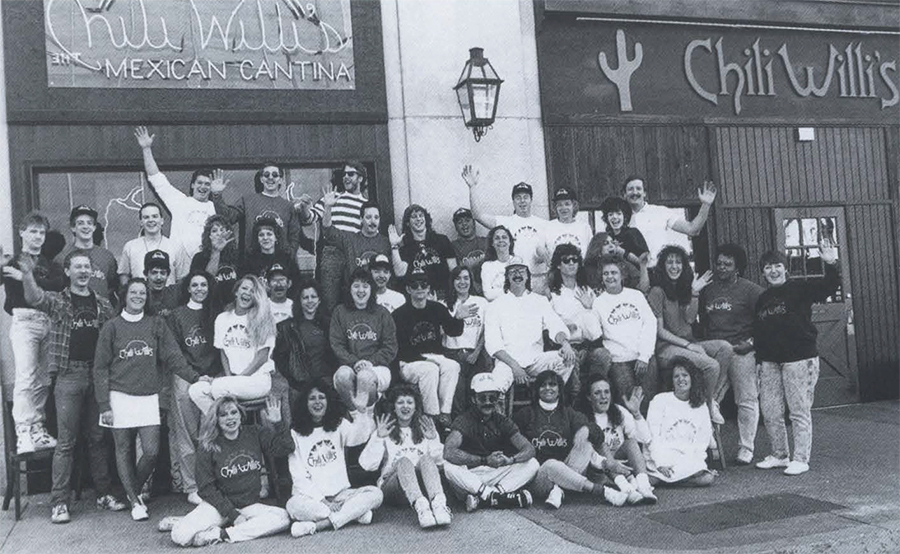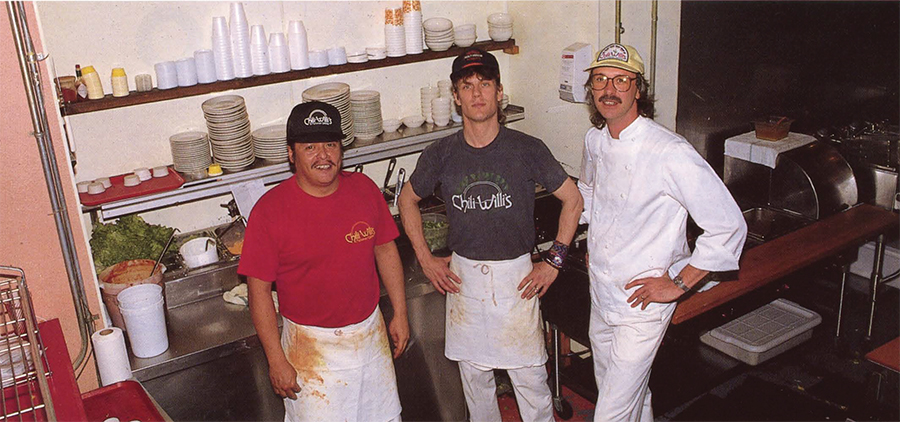Chili Willi’s boasts some of the best Tex-Mex feast in town, but beware of the “Bad Juan”
By Michael A. Friel
HQ 3 | SPRING 1990
Ron E. Smith knows that restaurants do not live by food alone. That’s why in 1983 when he opened Chili Willi’s Mexican Cantina, he set out not only to offer the best Mexican and Southwestern cuisine in the region, but to create an atmosphere that sends the senses South of the Border.
Today, large neon chili peppers hang in the windows. Murals, mirrors and painted cattle skulls accent green and pale peach walls. Behind a long red counter lined with curious patrons, the cast of cooks brings to life Smith cuisine creations. The aroma permeates the dining area. Employees, dressed in shorts, blue jeans, dresses and everything in between, scurry from table to counter to beyond, serving orders, clearing dishes, seating customers. The chatter of patrons mixes with rhythmic rock music.
“When I came up with the concept, I said I want it to be a restaurant that serves a drink and not a bar that serves food,” Smith explained. “I said, I want to have a kitchen out front. I want it to be busy. I want plates to be clanging, music to be playing, people to be talking and laughing. You know, a real boisterous sound that is a cantina.”
The 600 to 700 people who eat there on a busy Saturday are a testament to his success. Dining at Chili Willi’s is an experience. Once people try Chili Willi’s, they never forget it: They’re hooked.
“I wouldn’t think of coming to Huntington and not stopping in for a bowl of chili or something,” said Patrick Martorella, 21, of Beckley.
Like many students, Martorella began frequenting Chili Willi’s while at Marshall University.
“At one point I was going three or four times per week. I’d go in, sit down with a newspaper and often they would know to bring me a bowl of chili. It’s the best restaurant I’ve eaten at for the food and price. It’s genuine Tex-Mex food. They make it right in front of you, just like homemade.”
Smith, Chili Willi’s founder and coowner, meets a lot of people like Martorella. They arrive each day from such places as Charleston, Ashland, Ky., Ironton and Portsmouth, Ohio, and, of course, Huntington just to crunch the Cadillac Nachos, munch the fajitas, savor a bowl of the famous chili or sip exotic mixed drinks such as the powerful “Badjuan.”
“There are stories of a guy who flies down from Boston about once every other month so he can attend a meeting and come to Chili Willi’s for lunch,” Smith explained. “We tend to have people who have lived in Huntington and been regular customers of ours who have moved away. Whenever they come back to Huntington, for whatever reason, they always frequent us.”
Smith, in turn, crosses the continent searching for the perfect Mexican, Southwestern and Tex-Mex cuisine. His travels have taken him to such restaurants as the Coyote Cafe in Sante Fe, New Mexico, and the Mansion on Turtle Creek in Dallas, Texas. He will visit with owners and up-and-coming young chefs in his search for ways to improve upon existing dishes or create new ones. He may even roll up his shirt sleeves and cook. In late March, he ventured South of the Border on a two-week cooking tour of Mexico. “I take a basic dish and I interpret it, I guess. I come up with new dishes all the time,” he said. “I would like to add them to the menu, but the problem is the menu just keeps growing and growing and growing.”
Three of the best selling menu items are Cadillac Nachos, the fajitas and the chili, the recipe to which only Smith and kitchen manager Roy Clark know the secret.
Smith’s love for Mexican cooking began in the early 1970s as a hobby. Several years later he was asked to teach cooking classes around town. Then, in 1983, a friend suggested he share his Mexican dishes with the public by opening a cantina. In February of that year, Smith, who had developed his own dishes by reading cooking books and through experimentation, opened Chili Willi’s in a small building next to the Cinema Theatre.
Although he has owned other businesses, Smith has no formal culinary training and had never before worked in a restaurant.
“It took me about two weeks to sit down and put the concept together on paper – the menu and how I wanted the menu to be written and all. And once I had written the menu and devised it, I was thinking, ‘God, what am I going to name the restaurant?’ I kept thinking: ‘It’s got to be something kind of catchy.’ But I kept drawing blanks. Then, one day, I was in the shower and I remembered back to when I was in college and used to play music. I played in bands as a way to make money. After rehearsal, we would have jam sessions and we would lightheartedly call ourselves Chili Willi and the Red Hot Peppers. I remembered that in the shower and I went ‘Chili Willi’s. That has a ring to it.’ “
Yet Smith was reluctant, at first, to go with the name.
“I thought: ‘It’s too silly. People will laugh at it.'”
But it’s Smith who had the last laugh. His business flourished from the start. On weekends, lines would snake down Fourth Avenue like the Rio Grande, people hoping to get one of the small restaurant’s 35 seats. Word quickly spread. More people came, the lines grew longer. Smith and his staff could not continue to meet the demands for their cuisine.

In December 1985 Smith decided to expand Chili Willi’s by moving it to its present location, 841 4th Ave., which had more than 2,800 square feet, compared to just 800 at the original location. Last August another 440 square feet of dining space was added so that today the restaurant and bar seat 115 people.
Although Chili Willi’s could probably use more space, Smith fears that further expansion would destroy the atmosphere.
‘The way our kitchen is designed right now, it can just accommodate the seating we have. Frankly, one of the things people like about Chili Willi’s is the intimacy of it. It really feels like a cantina. It has a lot of atmosphere to it. I think the larger we get the more we lose that intimacy and that relationship with the customers. We’ve been very deliberate here at this location to try and keep in mind not to grow too fast.”
Smith, however, has not ruled out expansion in the Ashland market.
”We have looked at Ashland. Certainly we are interested in Ashland. What has stymied our growth into the Ashland market right now is that we have a tremendous amount of debt from Charleston.”
Chili Willi’s opened a second restaurant in the Capitol City in July 1987, but after just six months in business, Smith and his business associates were forced to close the 210 seat location. Today, he speaks openly about the restaurant’s failure.
Smith believes a number of factors contributed to the failure, including the location and the inability to duplicate the atmosphere, and staff.
On the other hand, he attributes much of the success of his Huntington business to the dedication and enthusiasm of his 52 employees. Several have been at Chili Willi’s since it opened in 1983.
Michelle Reese has worked as a waitress for three years.
“I’ve never worked as a waitress before and I wouldn’t work as one anywhere else,” she said. “It’s really great and a lot of fun. The customers are just like friends. We’re all friends. We pull together and work as a team.”
Chi-Chi’s, a national Mexican restaurant chain, broke ground in April on Huntington’s Superblock. And while Smith recognizes Chi-Chi’s as competition, he doesn’t feel threatened by the development.
“I think what will happen is that it will build the market up. Whether it was Chi-Chi’s or TGI Friday’s, initially, the same thing will happen to us. People will want to go over and try them. But as you draw more people into downtown, we’ll all do better.”
Smith said his cantina’s food differs from that of most chain Mexican restaurants. Others gear their menus toward baked or fried cuisine while Chili Willi’s emphasizes grilled food. It is freshness, however, that is of utmost importance. Lettuce, tomatoes and cheese are chopped and grated each day. The staff makes its own guacamole, which requires ripening eight to 12 cases of avocados at all times in various stages of ripeness. On a busy day, the restaurant uses up to 30 quarts of the green paste. As many as 15 chickens are cooked each day and the meat is pulled off the bones by hand.
What’s in store for Chili Willi’s?
Smith said his philosophy is “keep the doors open, keep the food good.” We haven’t crossed expansion out of our minds. When we feel comfortable and the right deal comes along, we might do something like open another location.”
Smith also is considering buying a tortilla machine to enable his staff to make fresh tortillas. Tortillas could then be made and sold to grocery stores and other restaurants. Chili Willi’s also has considered selling its salsa, sauces and bases.
‘There might be a market for that,” Smith said, “but it’s extremely expensive to try and go out and develop packaging and try and get grocery stores shelf space and all when you’re competing with major suppliers.”
But Smith is used to tough assignments.
When he opened Chili Willi’s in 1983, Huntington’s economy was lagging. Businesses were closing. The major retail chains had packed their wares and moved on to regional malls. Unemployment was high. Smith, however, thinks the picture was not that bleak.
“I think that there is a perception that downtown Huntington had faltered,” he said. “But if you look at any downtown in America with the exception of a few cities – like Cincinnati and Columbus – a lot of them have faltered with the advent of regional shopping malls becoming the new retail centers. But believe me, there are a lot more seedy downtowns than Huntington ever thought about. There are many things we need to be thankful for. We don’t have the strong chain retailers that we used to have in downtown because they moved on to regional shopping malls. So that’s left us with a lot of independents. They may not have the same shopping patterns as they should, but there are some real strong retailers downtown. They’re strong retailers because they offer good products and good service.”
While Huntington has just begun to awaken from its economic slumber in recent years, Chili Willi’s has enjoyed success from day one.
“I would like to think that’s why we have done so well,” Smith said. “I would like to think our Mexican food is as good as you can find in the Southwest or in Texas or in California.”





